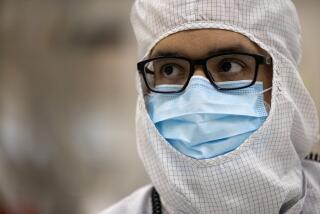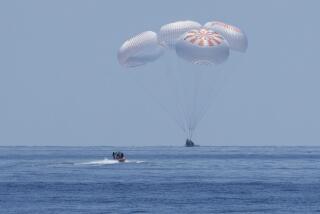Atlantis Passes NASA Inspection With A-OK
- Share via
CAPE CANAVERAL, Fla. — The crew of the space shuttle Atlantis spent nearly four hours Sunday inspecting the spacecraft with a robotic camera, but found nothing to worry about as it neared its rendezvous this morning with the International Space Station.
“Atlantis looks great,” said John Shannon, chairman of the shuttle’s Mission Management Team.
The six-person crew performed the inspection with a camera and laser attached to a 50-foot boom extending from a robotic arm.
At a news conference Sunday at Johnson Space Center in Houston, Shannon said engineers were looking at the images, along with pictures of the jettisoned external fuel tank, which show several divots in the insulating foam covering the tank’s aluminum skin.
Those divots came from an area known as the ice/frost ramps, where foam has been shed during previous missions. The ramps are being redesigned to prevent future shedding.
Foam has been a major concern for NASA since the 2003 Columbia tragedy, in which the craft was damaged during launch by a chunk of foam hitting its left wing, then broke up on reentry. Shannon said all the foam losses on Atlantis’ mission occurred too late in the launch sequence -- more than four minutes after liftoff -- to be a worry.
Today is crucial for the success of the mission, which is aimed at restarting construction of the half-built space station.
The first event occurs early this morning, when shuttle mission commander Brent Jett puts the craft into a kind of back flip as it approaches docking so that the space station crew can take close-up photos of the underside of the vehicle.
After docking, Atlantis’ crew will use the shuttle’s robotic arm to remove a large truss and a set of solar arrays from its cargo bay.
On Tuesday, mission specialists Joe Tanner and Heidemarie Stefanyshyn-Piper will venture out on the first of three spacewalks to begin installing the equipment on the space station.
When completed, the solar arrays will double the amount of power available on the station. The truss section will allow connection with future laboratories and other crew work spaces.
*
More to Read
Sign up for Essential California
The most important California stories and recommendations in your inbox every morning.
You may occasionally receive promotional content from the Los Angeles Times.













